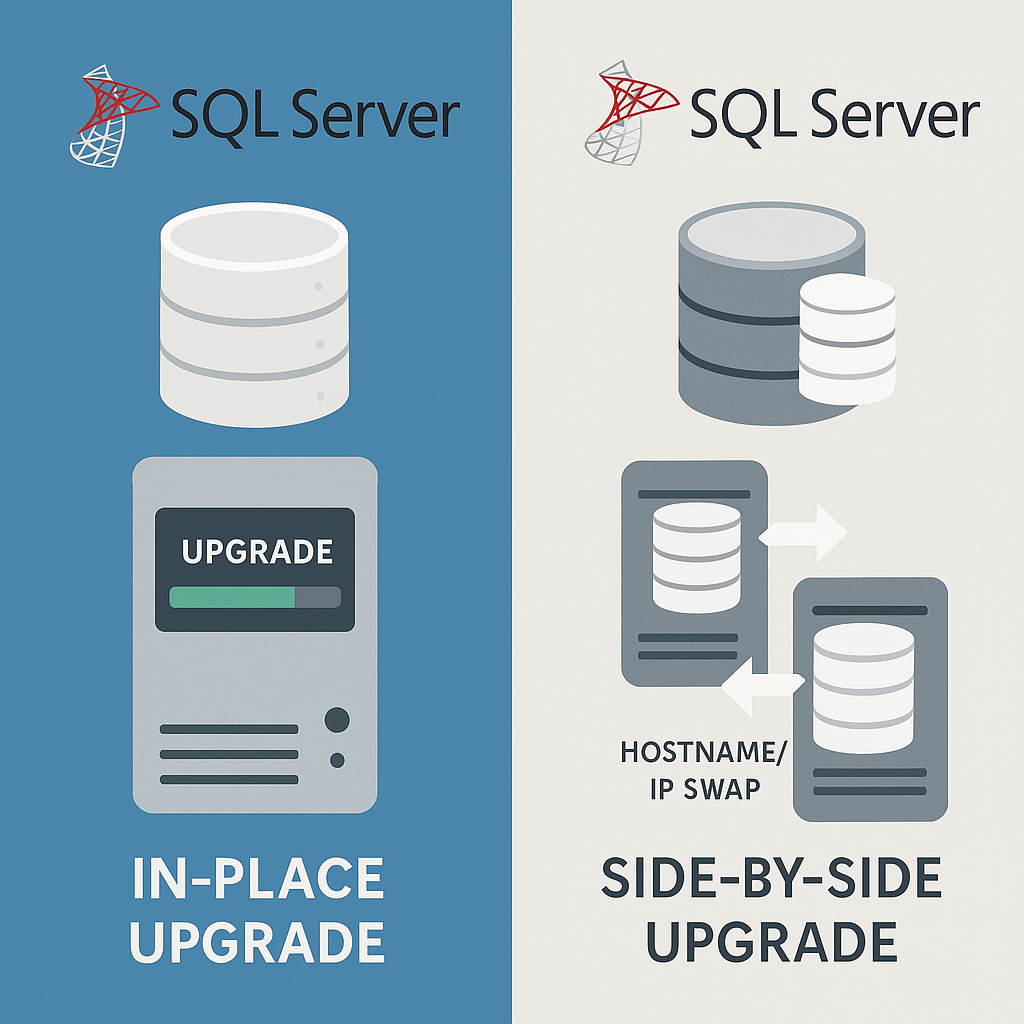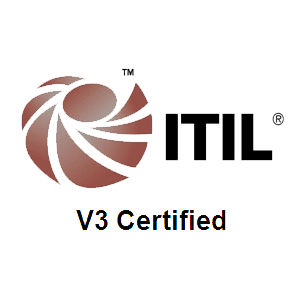Upgrading SQL Server is a mission-critical task for DBAs, especially when the goal is zero disruption to application connectivity. Whether you’re modernizing for performance, compliance, or supportability, choosing the right upgrade strategy is essential.
In this article, we’ll explore two proven upgrade paths:
- In-Place Upgrade
- Side-by-Side Upgrade with Hostname/IP Swap
We’ll also cover step-by-step procedures, best practices, and real-world examples to help you make an informed decision.
🔁 In-Place Upgrade
📌 What Is It?
An in-place upgrade installs the new SQL Server version directly over the existing instance, replacing binaries and upgrading system/user databases.
🛠️ Step-by-Step Guide
- Pre-Upgrade Planning
- Run Data Migration Assistant (DMA) to identify deprecated features.
- Validate OS compatibility with the target SQL Server version.
- Backup all databases, including system DBs.
- Document server-level objects (logins, jobs, linked servers).
- Schedule Downtime
- Notify stakeholders.
- Stop application services or enable maintenance mode.
- Perform the Upgrade
- Launch SQL Server Setup → Select Upgrade from a previous version.
- Follow the wizard and complete the upgrade.
- Post-Upgrade Tasks
- Apply latest cumulative updates.
- Rebuild indexes and update statistics.
- Validate application functionality.
- Monitor logs and performance metrics.
✅ Pros
- No need to change connection strings.
- Simple and fast for small environments.
- Retains all server-level configurations.
❌ Cons
- High risk: Rollback is complex.
- Downtime is unavoidable.
- No parallel testing environment.
🧠 Best Practices
- Always snapshot the VM before upgrade.
- Use SQL Server Setup Logs to troubleshoot failures.
- Avoid in-place upgrades for mission-critical systems 1.
🔄 Side-by-Side Upgrade with Hostname/IP Swap
📌 What Is It?
This method involves setting up a new SQL Server instance (on new hardware or VM), migrating databases and server objects, and swapping the identity (hostname, IP, or DNS alias) to avoid changing application connection strings.
🛠️ Step-by-Step Guide
- Prepare New Environment
- Install SQL Server with matching or improved configuration.
- Apply latest patches and service packs.
- Script out and recreate server-level objects (logins, jobs, linked servers).
- Database Migration
- Use backup/restore, log shipping, or DBATools for migration.
- Validate data integrity and consistency.
- Swap Identity
- Rename the new server to match the old one (if domain-joined).
- Or update DNS/CNAME to point to the new server.
- Restart SQL Server services.
- Cutover and Validation
- Stop old SQL Server.
- Validate application connectivity.
- Monitor performance and logs.
✅ Pros
- Low risk: Old server remains intact.
- Enables parallel testing.
- Minimal downtime during cutover.
❌ Cons
- Requires additional hardware or VM.
- More complex planning and execution.
- Server renaming can affect SSRS/SSIS/AGs.
🧠 Best Practices
- Use SQL Server Upgrade Advisor to detect compatibility issues.
- Maintain a rollback plan with full backups.
- Document every step for audit and repeatability 2.
🧪 Real-World Case Study
Industry: Insurance
Scenario: A large insurance firm needed to upgrade from SQL Server 2012 to 2019 across 30+ applications without changing connection strings.
Approach:
- Deployed new SQL Server 2019 instances.
- Migrated databases using backup/restore.
- Recreated logins, jobs, and linked servers.
- Used DNS aliasing to point applications to the new servers.
Outcome:
- Zero application changes.
- Minimal downtime during cutover.
- Full rollback capability retained 3.
📊 Comparison Table
| Feature | In-Place Upgrade | Side-by-Side (Swap) |
|---|---|---|
| Downtime | High | Low |
| Rollback Capability | Poor | Excellent |
| Hardware Requirement | None | Yes |
| Parallel Testing | No | Yes |
| Risk Level | High | Low |
| Complexity | Low | Medium |
| Connection String Change | No | No |
🏁 Final Thoughts
Choosing between in-place and side-by-side upgrades depends on your environment’s complexity, risk tolerance, and downtime window. For non-critical systems, in-place upgrades are quick and efficient. For enterprise-grade systems, side-by-side upgrades with hostname/IP swap offer maximum control, safety, and flexibility.
#SQLServerUpgrade,#DatabaseMigration,#InPlaceUpgrade,#SideBySideUpgrade,#SQLServer2022,#SQLServerBestPractices,#ZeroDowntime,#DatabaseAdmin,#SQLServerTips,#SQLServerBlog,#SQLServerPerformance,#SQLServerPlanning,#SQLServerCutover,#SQLServerRollback,#SQLServerTesting,#SQLServerBackup,#SQLServerRestore,#SQLServerDNS,#SQLServerAlias,#SQLServerHostnameSwap,#SQLServerInfrastructure,#SQLServerModernization,#SQLServerStrategy,#SQLServerDeployment,#SQLServerMonitoring,#SQLServerSecurity,#SQLServerAutomation,#SQLServerDevOps,#SQLServerCloud,#SQLServerEnterprise


